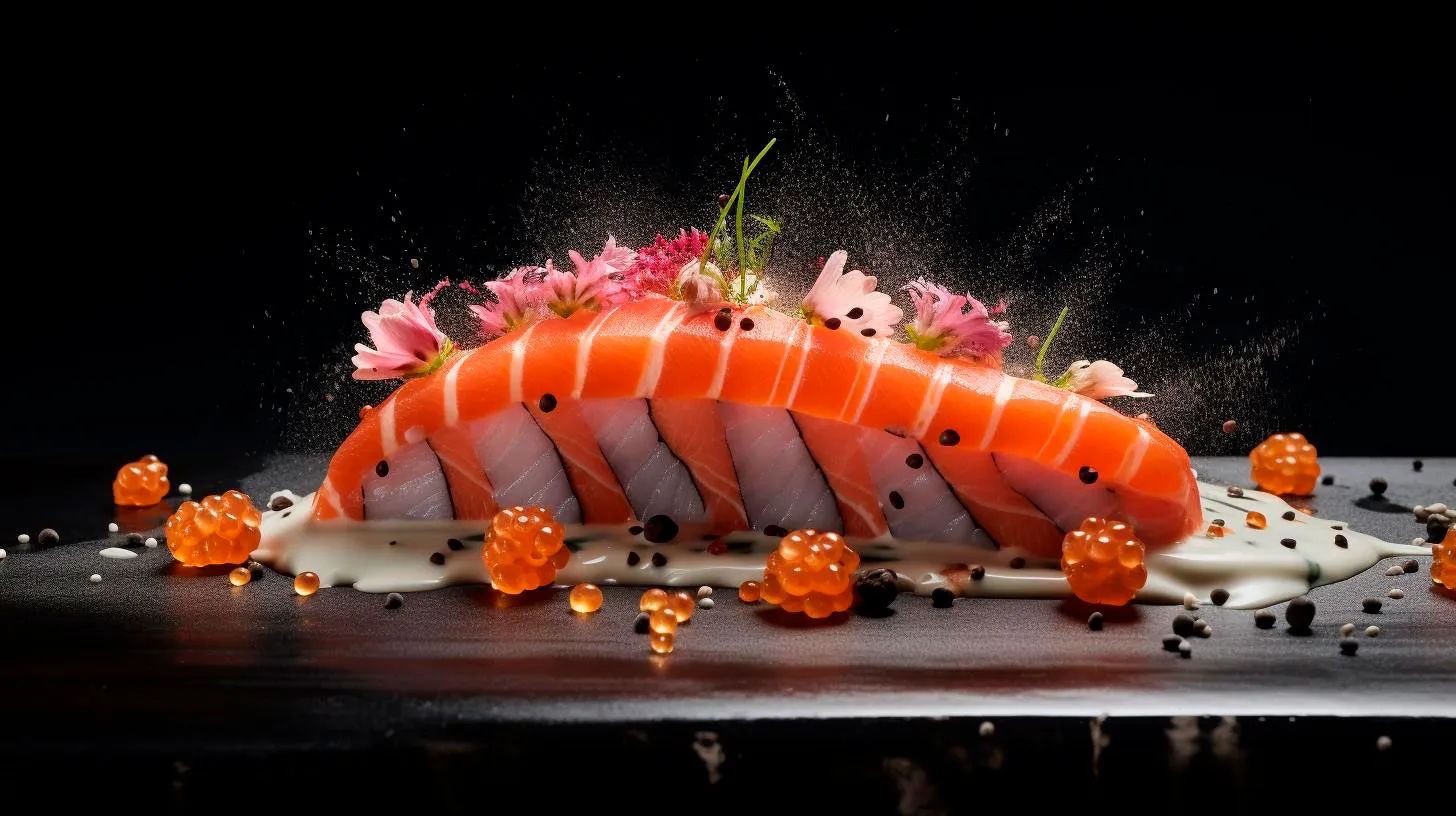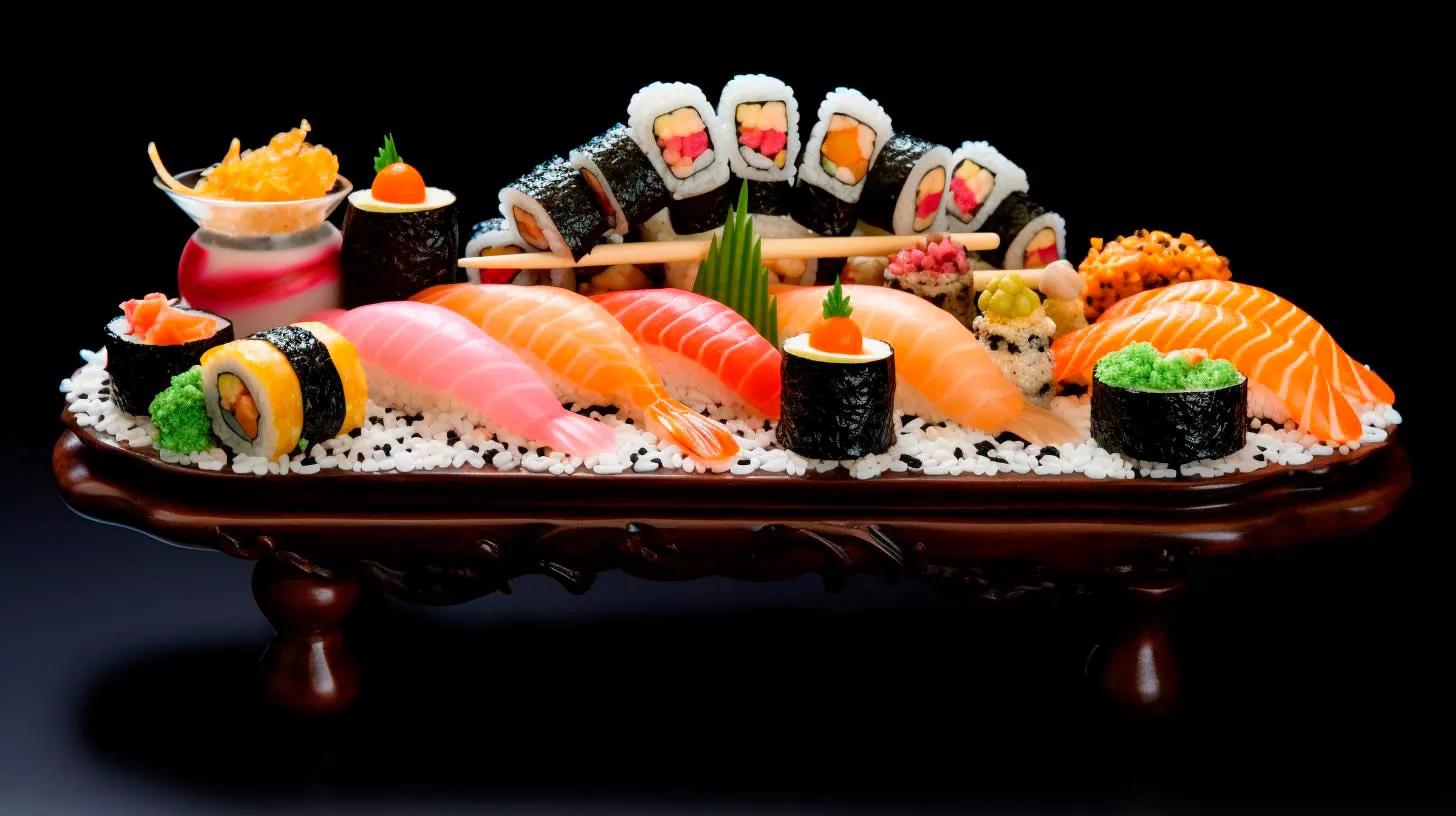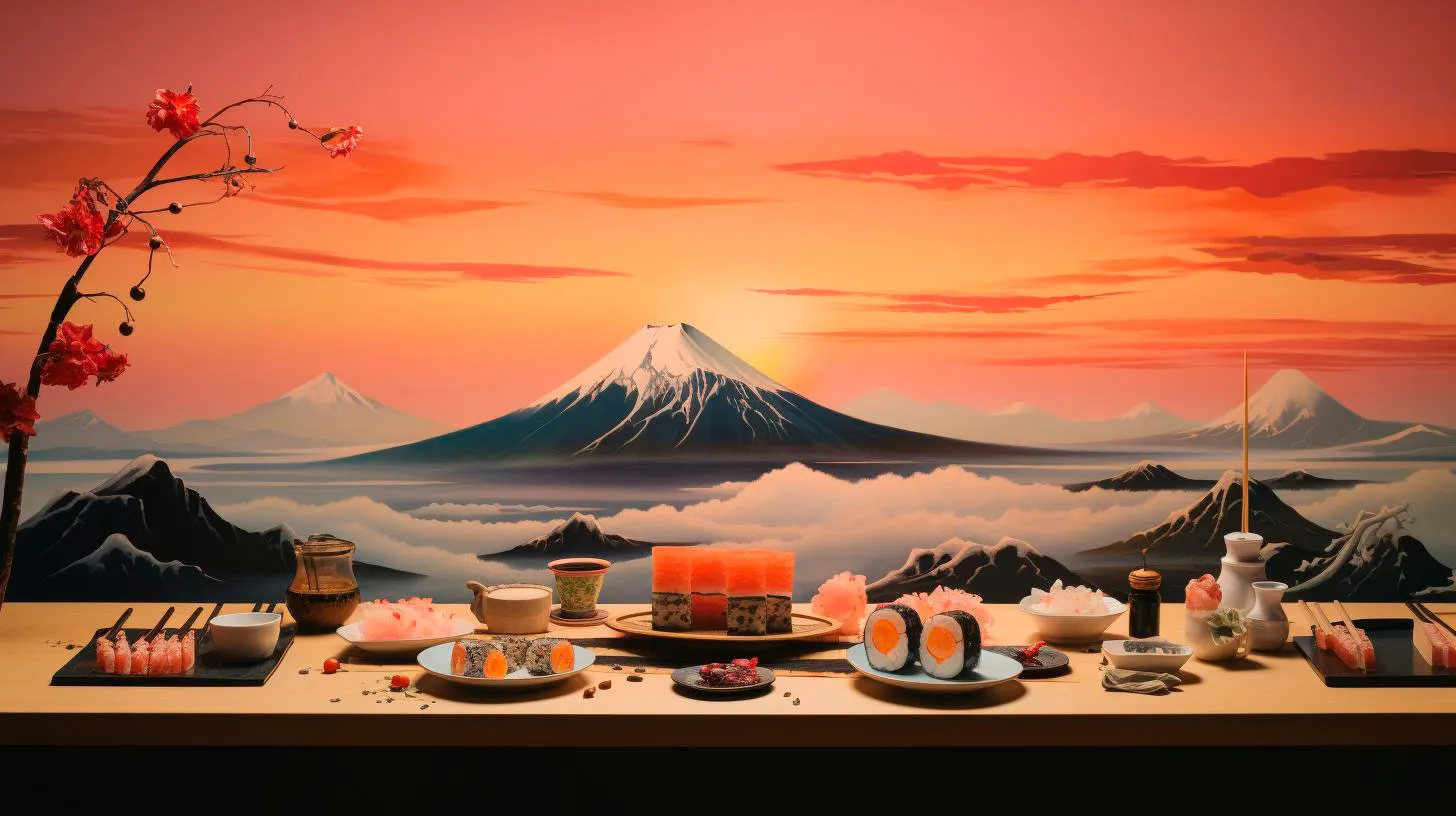Sushi Love: A Culinary Obsession
Let’s dive into the fascinating world of sushi, exploring its history, varieties, health benefits, and the cultural significance it holds.
A Brief History of Sushi
Sushi traces its roots back to ancient Southeast Asia, where fish was fermented with rice to preserve it. This preservation technique slowly spread to other parts of Asia before eventually making its way to Japan. In the early days, sushi was enjoyed as a quick snack, with the rice discarded and only the fish consumed. However, over time, people started to realize the delightful combination of rice and fish, leading to the development of what we now recognize as sushi.
In the 19th century, Tokyo became the birthplace of modern sushi. A street food vendor named Yohei Hanaya popularized the nigiri-style sushi we now enjoy. He started serving bite-sized fish atop bite-sized vinegared rice, forever changing the sushi landscape. Since then, sushi has continued to evolve, embracing various techniques and ingredients to keep up with changing tastes.
Types of Sushi
Sushi is not just a singular dish; it encompasses a diverse range of styles and flavors. Here are some of the most popular types of sushi:
- Nigiri: This classic style features a slice of fresh fish or seafood placed over a small mound of vinegared rice.
- Maki: Maki sushi consists of rice and various fillings rolled tightly in a sheet of seaweed called nori.
- Sashimi: Unlike other sushi varieties, sashimi lacks rice and focuses solely on thinly sliced raw fish or seafood.
- Temaki: Temaki, or hand roll sushi, is a cone-shaped piece of nori filled with rice, fish, and vegetables.
- Uramaki: Uramaki rolls are inside-out rolls where the rice is on the outside and the nori wraps around the fillings.
The Health Benefits of Sushi
Sushi isn’t just a delicious treat; it also offers several health benefits. Here are some key reasons why sushi has gained a reputation as a healthy option:
- Rich in Omega-3: Fish like salmon and tuna used in sushi are abundant sources of omega-3 fatty acids, which are essential for heart health and brain function.
- Low in Calories: Sushi is typically low in calories, making it an excellent choice for those watching their weight.
- Packed with Nutrients: Sushi provides a range of essential nutrients, including vitamins, minerals, and antioxidants.
- Good Source of Protein: Sushi is an excellent source of high-quality protein, aiding in muscle growth and repair.
- Healthy Carbohydrates: The rice used in sushi provides slow-release carbohydrates, giving you sustained energy.
The Cultural Significance of Sushi
Sushi is not just a meal; it is a symbol of Japanese culture and tradition. Here are a few reasons why sushi holds cultural significance:
- Artistic Presentation: Sushi chefs take great pride in the art of sushi-making, arranging each piece with meticulous care and attention to detail.
- Social Bonding: In Japan, sushi is often enjoyed in groups, promoting social interaction and fostering a sense of community.
- Seasonal Sensibility: Sushi chefs prioritize using fresh, seasonal ingredients, reflecting the connection between nature and food.
- Japanese Philosophy: Sushi embodies principles of simplicity, balance, and harmony – core tenets of Japanese culture.
Key Takeaways
Sushi’s journey from a humble street food to a globally adored cuisine is a testament to its irresistible flavors and cultural significance. Here are the key takeaways from our exploration of sushi:
- Sushi originated in Southeast Asia and evolved into the diverse culinary art we know today.
- Types of sushi include nigiri, maki, sashimi, temaki, and uramaki – each offering unique flavors and textures.
- Sushi offers numerous health benefits, including the presence of omega-3 fatty acids and essential nutrients.
- Sushi showcases the artistry and cultural values of Japan, emphasizing the importance of aesthetics, community, and seasonal ingredients.
So, the next time you indulge in a plate of sushi, remember that you are not just savoring a delicious dish but also experiencing a rich tapestry of history, culture, and culinary craftsmanship. Sushi truly is a culinary obsession worth exploring!
Savoring the Sushi: Unveiling the Allure of Sushi Tattoos
Sushi tattoos have become increasingly popular among both sushi aficionados and tattoo enthusiasts, adding a new dimension to the art of body ink. In this article, we will delve into the fascinating world of sushi tattoos, exploring their meaning, significance, and growing popularity.
The Artistry Behind Sushi Tattoos
For many, getting a tattoo is a bold statement and a way to showcase their personality or interests. Sushi tattoos offer a unique opportunity to combine the love for food with artistic expression. These tattoos often feature intricate details, vibrant colors, and meticulous representations of sushi rolls, sashimi, or even chopsticks. From traditional Japanese style to more modern and abstract designs, sushi tattoos encompass a wide range of artistic styles, allowing individuals to showcase their personal taste and creativity.
Moreover, sushi tattoos can be more than just a visual representation. Some tattoo artists incorporate elements that engage multiple senses, such as adding the scent of wasabi or soy sauce essence to the ink used. This truly immersive experience adds an extra layer of authenticity to the art and creates a unique bond between the tattoo and its wearer.
The Meaning and Significance of Sushi Tattoos
Like any other tattoo, sushi tattoos can hold different meanings for different people. For some, it may simply represent their love for sushi and their connection to Japanese cuisine. Others may see sushi tattoos as a manifestation of their adventurous spirit and willingness to try new things. Additionally, sushi tattoos can represent a deeper connection to Japanese culture, symbolizing respect for its traditions and aesthetic.
In recent years, sushi tattoos have also gained popularity among sushi chefs and restaurant owners. These tattoos serve as a mark of their profession and demonstrate their dedication to the art of sushi-making. By sporting a sushi tattoo, chefs can proudly showcase their expertise and commitment while adding an extra touch of authenticity to their culinary creations.
The Rising Popularity of Sushi Tattoos
Sushi tattoos have become increasingly popular in recent years, with social media platforms playing a significant role in their rise to fame. Instagram, in particular, has been a driving force behind the sushi tattoo trend. Tattoo artists and enthusiasts from around the world share their unique designs and creations, inspiring others to jump on the sushi tattoo bandwagon. As a result, sushi tattoos have become a prominent feature on many people’s Instagram feeds.
Another key factor contributing to the popularity of sushi tattoos is the growing acceptance of tattoos in society. Once seen as taboo or associated with criminal activity, tattoos are now widely accepted as a legitimate form of self-expression. As a result, people are increasingly open to showcasing their love for sushi and their appreciation for all things Japanese through body art.
Key Takeaways
- Sushi tattoos offer a unique opportunity to combine the love for food with artistic expression.
- They incorporate intricate details, vibrant colors, and meticulous representations of sushi.
- Some sushi tattoos engage multiple senses, adding scents like wasabi or soy sauce essence to the ink.
- These tattoos can hold different meanings for different people, from a simple love for sushi to a deeper connection to Japanese culture.
- Social media, particularly Instagram, has played a significant role in popularizing sushi tattoos.
- Acceptance of tattoos in society has also contributed to the rise of sushi tattoos.
In conclusion, sushi tattoos have emerged as a remarkable trend, combining the love for sushi with the art of tattooing. These tattoos encapsulate the artistry, creativity, and personal significance that come with body art. Whether it’s a representation of personal taste or a connection to Japanese culture, sushi tattoos offer a unique and captivating way to express oneself. So, if you find yourself head over heels for sushi and seeking a permanent mark of your passion, perhaps a sushi tattoo is the perfect choice for your next artistic adventure.
The Enduring Art: Exploring the History of Sushi Tattoos
Combining the beauty and intricacy of sushi with the permanence of body art, sushi tattoos have become a unique way for individuals to display their love for this Japanese delicacy. Let’s dive deeper into the history of sushi tattoos, their significance, and the enduring art they represent.
The Rise of Sushi Tattoos
In recent years, sushi has exploded in popularity across the globe. Its fusion of flavors, artistic presentation, and cultural significance have made it a go-to choice for food enthusiasts worldwide. As a result, sushi has become more than just a meal – it has become a lifestyle.
With the growing interest in sushi, it was only a matter of time before this culinary fascination merged with the art of tattooing. Sushi tattoos began appearing on the skin of sushi aficionados, showing off their passion for this iconic Japanese cuisine.
Significance of Sushi Tattoos
Sushi tattoos carry a deep significance for those who choose to adorn their bodies with these unique designs. Here are a few reasons why sushi tattoos hold such sentimental value:
- Cultural Connection: Sushi is deeply rooted in Japanese culture and has been around for centuries. Those who opt for sushi tattoos often feel a strong connection to Japanese traditions and want to pay homage to the country’s rich culinary heritage.
- Individuality: Sushi tattoos allow individuals to showcase their love for this beloved food and express their unique personality through body art. Each sushi tattoo is distinct in its design, offering a creative outlet for self-expression.
- Symbolic Significance: Sushi is often associated with concepts of balance, simplicity, and beauty. By choosing a sushi tattoo, some individuals aim to incorporate these principles into their own lives, emphasizing the importance of harmony and aesthetic appeal.
The Enduring Art of Sushi Tattoos
Sushi tattoos hold a timeless allure due to their enduring artistry. Here’s why sushi tattoos have stood the test of time:
- Creative Design Possibilities: Sushi’s visual appeal lends itself well to the art of tattooing. From delicate nigiri to intricately rolled maki, sushi tattoos offer endless opportunities for artists to showcase their skills and imagination.
- Attention-Grabbing Aesthetics: Sushi tattoos tend to be vibrant, colorful, and eye-catching, instantly drawing attention wherever they go. Their striking visuals and attention to detail make them a captivating choice for tattoo enthusiasts.
- Conversation Starters: Sushi tattoos spark curiosity and intrigue, often initiating conversations about Japanese culture, culinary experiences, and personal passions. They provide a unique opportunity to connect with others who share the same interests.
The Fascination with Sushi Tattoos
The fascination with sushi tattoos extends far beyond the realm of body art. Here are a few key takeaways that delve into the allure of these remarkable tattoos:
- A Unique Blend of Traditions: Sushi tattoos beautifully blend the traditional art forms of Japanese cuisine and tattooing, creating a harmonious fusion that resonates with individuals seeking a distinctive form of self-expression.
- Embracing Culinary Appreciation: Sushi tattoos celebrate the appreciation for food and the artistry involved in its creation. They serve as a constant reminder of the joy and satisfaction that is derived from savoring a well-made sushi roll.
In conclusion, sushi tattoos offer a unique and enduring form of self-expression for those who appreciate the fusion of culinary art and body art. Their significance lies in the connection to Japanese culture, individuality, and symbolic representation. The mesmerizing aesthetics of sushi tattoos, along with their ability to start conversations and ignite curiosity, make them a remarkable choice for tattoo enthusiasts. As the art of sushi continues to evolve, so too will the enduring allure of sushi tattoos.
Sushi Tattoos: A Fusion of Culture and Ink
In this article, we will explore the fascinating world of sushi tattoos, their meaning, and the rise of this trend.
The Artistry of Sushi Tattoos
Sushi tattoos are a true testament to the creativity and artistry of tattoo artists. Just like a skilled sushi chef meticulously crafts each roll, tattoo artists apply intricate details and vibrant colors to bring these edible works of art to life on the skin. From delicate nigiri sushi pieces to beautiful sushi rolls, these tattoos display an impressive level of precision and attention to detail.
Key takeaways:
- Sushi tattoos showcase the artistry and creativity of tattoo artists.
- Intricate details and vibrant colors bring sushi tattoos to life.
- Precision and attention to detail are essential in capturing the essence of sushi.
Sushi Tattoos: A Symbolic Fusion
Beyond their aesthetic appeal, sushi tattoos hold symbolic meanings for those who choose to wear them. They serve as a fusion of cultures, blending the art of sushi-making with the timeless tradition of tattooing. These tattoos can represent a deep appreciation for Japanese culture, a love for sushi, or a personal connection to Asian heritage.
With their popularity on the rise, sushi tattoos have also become a symbol of individuality. People who opt for sushi tattoos often embrace their uniqueness and use this body art as a way to express their passion for sushi and their own personal style.
Key takeaways:
- Sushi tattoos symbolize the fusion of sushi-making and tattooing traditions.
- They represent an appreciation for Japanese culture and a love for sushi.
- Sushi tattoos can be a statement of individuality and personal style.
The Rise of Sushi Tattoos
The popularity of sushi tattoos has seen a significant surge in recent years. Sushi lovers and tattoo enthusiasts alike are drawn to these unique designs that embody both culinary art and body art. Social media platforms have played a pivotal role in amplifying this trend, showcasing stunning sushi-inspired tattoos to a wider audience.
These tattoos have also gained popularity among chefs and restaurant owners, further cementing their place in food culture. Chefs are known for their passion and dedication to their craft, and getting a sushi tattoo can be a way for them to display their love for their profession while adding a touch of artistic flair.
Key takeaways:
- Sushi tattoos have experienced a surge in popularity.
- Social media platforms have played a crucial role in amplifying this trend.
- Sushi tattoos are also favored by chefs and restaurant owners.
In Conclusion
Sushi tattoos are more than just ink on skin; they are a fusion of culture and a canvas for self-expression. These tattoos celebrate the artistry of sushi-making while serving as symbols of individuality and appreciation for Japanese culture. As the popularity of sushi tattoos continues to rise, we can expect to see more stunning designs that showcase the beauty of sushi in artistic form.


